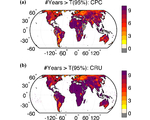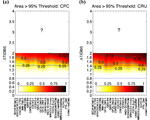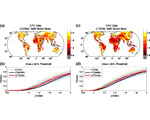Near-term increase in frequency of seasonal temperature extremes prior to the 2°C global warming target
Bruce T. AndersonDepartment of Geography and Environment, Boston University, Boston, MA, U.S.A.
Abstract
Given current international efforts to reduce greenhouse gas emissions and limit human-induced global-mean near-surface temperature increases to 2 °C, relative to the pre-industrial era, we seek to determine the impact such a temperature increase might have upon the frequency of seasonal-mean temperature extremes; further we seek to determine what global-mean temperature increase would prevent extreme temperature values from becoming the norm. Results indicate that given a 2 °C global mean temperature increase it is expected that for 70–80% of the land surface maximum seasonal-mean temperatures will exceed historical extremes (as determined from the 95th percentile threshold value over the second half of the 20th century) in at least half of all years, i.e., the current historical extreme values will effectively become the norm. Many regions of the globe — including much of Africa, the southeastern and central portions of Asia, Indonesia, and the Amazon — will reach this point given the “committed” future global-mean temperature increase of 0.6 °C (1.4 °C relative to the pre-industrial era) and 50% of the land surface will reach it given a future global-mean temperature increase of between 0.8 and 0.95 °C (1.6–1.75 °C relative to the pre-industrial era). These results suggest substantial fractions of the globe could experience seasonal-mean temperature extremes with high regularity, even if the global-mean temperature increase remains below the 2 °C target.










No comments:
Post a Comment